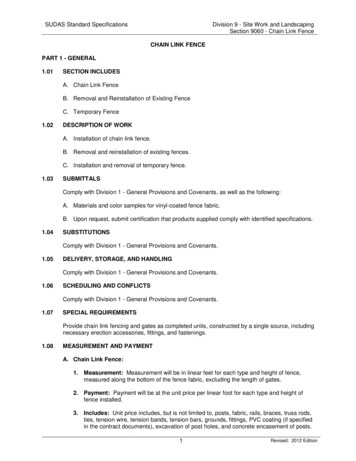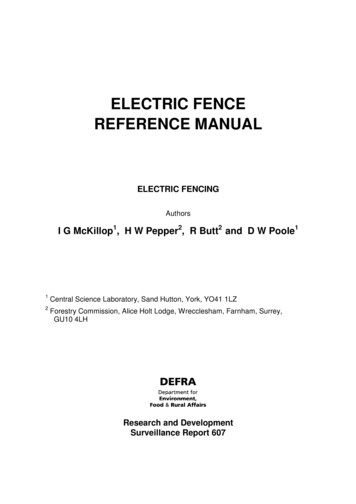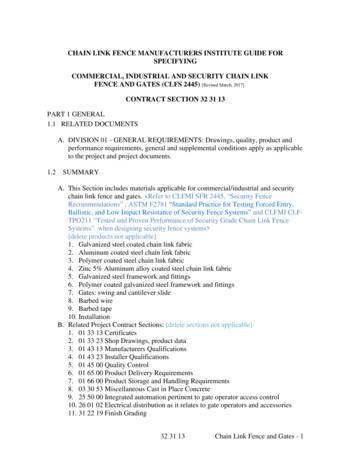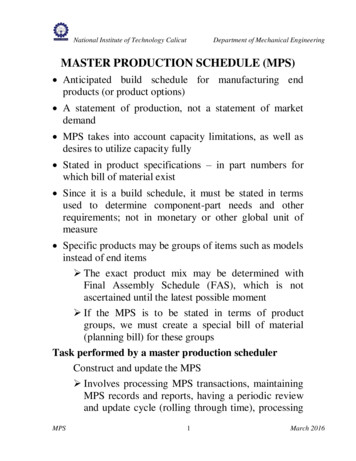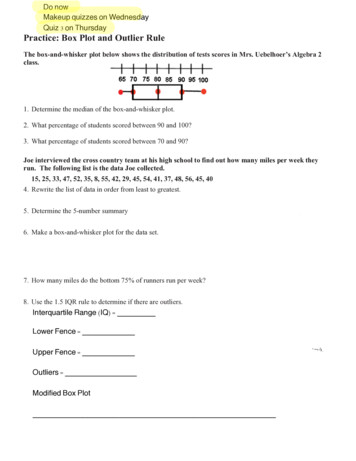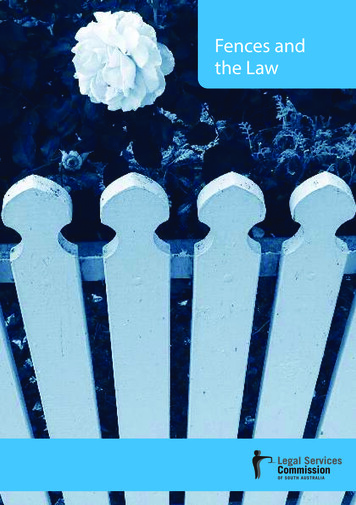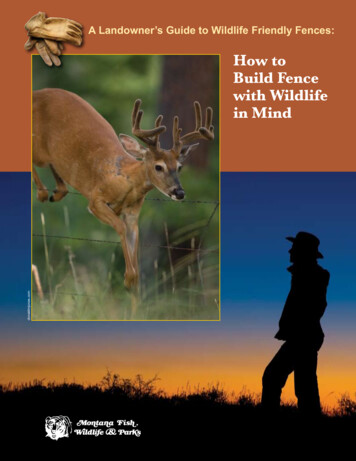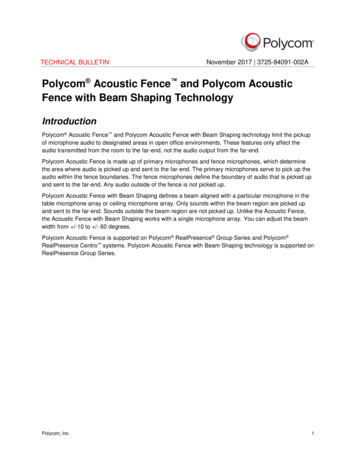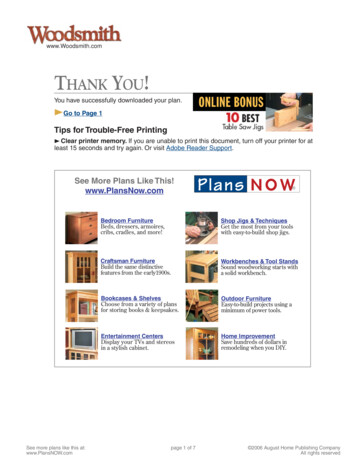
Transcription
Chapter 5, Section 2FenceFL600.0505(h) Purpose and objectiveThe purpose of this supplement is to provideguidance and specification information for use inthe design and construction of fences in Florida.Determining What Kind Of Fence To UseFences shall be selected to provide adequatecontrol of the type animals present or planned.Other factors that should be considered includecost, life span and maintenance. Table FL5-1provides information that can be used tocompare various types of fences.Boundary fences shall meet or exceed theminimum requirements shown in Exhibit FL5-1for “Legal Fence Requirements” and all locallaws and regulations.Barbed Wire FencesStandard barbed wire fences are the mostcommon method of fencing for cattle and otherlarge animals due to the cost and relative easeof construction. There are two (2) main types ofbarbed wire fences: standard (regular) andsuspension (high tensile non-energized) fences.Standard barbed wire fences commonly havefive (5) to six (6) line posts per 100 feet of fenceand three (3) to six (6) strands of wire. The four(4) strand fence is the most common. This typefence provides good control for cattle and canbe used for horses. As general rule barbed wireshould not be used for horses due to the highpotential for injury. However, this type fence canbe used if the pastures are large and there arefew places where the horses will congregatenext to the fence. Three (3) strand fencesprovide fair control of cattle when used asinterior cross fences. Three (3) wire fences arenot acceptable for use as boundary fences. Five(5) and six (6) strand fences can be plannedwhen the cattle are wild and the additional fencestrength is needed.Spacing posts 15 to 20 feet apart with staysinserted between the posts is recommended formost barbed wire fences. Spacing line postscloser than 15 feet will significantly increase thecost of the fence construction, without acorresponding increase in strength. Forexample material cost for one (1) mile of fencewill be increased 35% if posts are spaced 10feet apart.Spacing posts at 30 feet intervals isrecommended for very large pastures with lowstock densities (generally rangeland). This willdecrease the cost of fence construction. Staysshall be placed at no more than 15 foot intervalswhen this spacing is used. Posts spacingshould be decreased near gates and other areaswhere livestock will congregate.Posts should be placed at closer intervals (12 to15 feet) in areas of irregular terrain or where theanimals will congregate. These areas generallyoccur near gates, watering facilities,supplemental feeders or shaded areas.Suspension fences are a low cost variation ofbarbed wire fence that can be used onrangelands and large pastures. The completedfence will move (sway) in the wind or whenanimals strike it. Because of the swaying actionof this type of fence the wires need to beattached to the post so they can move freely.Post spacing for this type of fence may rangefrom 30 to 100 feet. This type of fence shouldconsist of three (3) to six (6) stands of barbedwire.Distance between stays or stays and posts shallnot exceed 15 feet (allowable variance 10inches). Stays shall be inserted so that thelower ends of the stays do not touch the ground.Wire tension is very critical in the success of thistype of fence. The wires shall be stretched sothere is no more than three (3) inches of sagbetween fence posts when posts are spaced100 feet apart, or 1 ½ inches when posts arespaced 50 feet apart.Woven Wire FencesWoven wire provides good control of most typesof animals. These fences are generally 20 to100% more expensive to construct than a four(4) strand barbed wire fence. Woven wirefences shorter than 38 inches will require one(1) or more strands of barbed wire installedabove the woven wire to provide adequatecontrol of large animals. Installing the wovenwire two (2) four (4) inches above the groundwith a barbed or energized wire installed two (2)inches above the ground is effective in(190-vi-NRHP, Supplement Fl-1 May 1999)FL14-1
Chapter 5, Section 2Fencepreventing small animals from burrowing underthe fence.corral fences. Posts should be spaced five (5)to six (6) feet apart where crowding will occur.Consideration should be given to the size ofopenings in woven wire where horned animals,such as goats are to be controlled. Smallopenings present less opportunity for theanimals to entangle themselves.Boards should be attached to a flat face on thepost using three and one half inch (3 ½”) long(16d common), galvanized, spiral or ringshanked nails. Joints where boards butt upagainst each other should be staggered so thateach board spans two or more posts.Line post spacing for woven wire fences shallnot exceed 20 feet. Posts should be placed atcloser intervals (12 to 15 feet) in areas ofirregular terrain or where animals willcongregate. These areas generally occur neargates, watering facilities, supplemental feedersor shaded areas.Woven wire fences can present a significantbarrier to wildlife. For this reason woven wirefences are not recommended for use asboundary fences, unless the goal is to controlwildlife. To control large wildlife such as deer,the fence should be constructed of a doubleheight of woven wire.Board fencesBoard fences are recommended in areas wherethe main concerns are safety or aesthetics.Board fences are one of the most expensivetypes of fence to build and maintain. Thesefences should be used when fencing is neededfor horses. Board fences should also be usedwhen constructing cowpens and other workingfacilities for livestock. Criteria for selectingmaterials for board fences is shown in TableFL5-5.Typically, field fences shall be constructed ofthree (3) to four (4) boards attached to woodenposts (4” dia. min.). Boards shall be a minimumof one (1) inch by six- (6) inch rough cut lumber.The minimum height of field fences is shown intable FL5-2. Posts are usually spaced eight (8)feet apart for field fences and can be spaced ten(10) feet apart if boards 20 feet in length areused.Board fences for barn lots, cowpens or corralsshall be constructed of four (4) or more boardswith a minimum height of five (5) feet. Tallerfences should be planned for animals that arewild or are known to escape over five (5) footfences. Boards shall be a minimum of two- (2)inch by six- (6) inch rough cut lumber. Posts areusually spaced six (6) to eight (8) feet apart forHigh tensile, non-energized fencesHigh tensile, smooth wire fences are becomingincreasingly popular for farm fences. Thesefences are typically constructed with four (4) toten (10) smooth wires. A six- (6) strand, hightensile fence will provide adequate control oflivestock and can be constructed to control largewildlife. A ten- (10) strand, high tensile, nonenergized fence will cost approximately 2/3 of anequivalent woven wire fence.These fences are constructed of 12 ½ gage,class 3 wire, with a minimum tensile strength of160,000 pounds per square inch (psi),galvanized steel wire. Wire tension for hightensile fences shall be minimum 150-300 lb.tension per wire.Wires are held in tension along the posts orposts and stays through the use of in-linestrainers. A tension indicator spring may beused to indicate wire tension. Wires must beattached to the posts in such a fashion that thewires may freely move back and forth. This willallow the fence to maintain sufficient elasticity towithstand high pressure ( 1,100 lbs.) fromanimals and contractions in the wire due totemperatures.Commercial mechanical fasteners arerecommended for joining high tensile wire.Other splices and knots used to attach wires toposts or to join wires may be used if theyconform to type of wire being used. Wire splicestraditionally used to join barbed or woven wireare not recommended for high tensile wire.These splices usually fail at 60% of the breakingstrength of the wire.Line post spacing may vary from 16 feet withoutstays to 100 feet if stays are used. Distancebetween stays or stays and posts shall notexceed 15 feet (allowable variance 10”).(190-vi-NRHP, Supplement Fl-1 May 1999)FL14-2
Chapter 5, Section 2FenceEnergized (Electric) FencesElectric fences provide a low cost alternative forpasture permanent and temporary cross fencesin pastures. These fences can be constructed toprovide adequate control for most classes ofanimals. Electric fences with less than three (3)wires shall not be used as boundary fences.Permanent cross fence should be constructed oftwo (2) to six (6) strands of wire with postsspaced 20 to 30 feet apart.Temporary cross fences may be constructed ofone (1) or more strands of wire. A two- (2)strand temporary fence is recommended for bestresults. These fences are not eligible for costshare payments.Animals to be controlled by energized fencesshould be trained to respect the fence. This canbe accomplished by erecting a short span ofenergized fence in a corral or other relativelysmall, secure area. Grain or green feed may beplaced behind the fence to attract the animalsand come in contact with the fence. Moisteningthe earth below the fence will ensure aneffective shock.Improper earthing (grounding) and damage fromlightening strikes are the most common causesof fence failure. Three (3), galvanized groundrods are recommended to ensure a wellgrounded system. The ground rods shouldextend at least six (6) feet into the soil. Connectthe ground rods to the energizer using one (1)continuous wire. Do not use painted, thinlyelectroplated or ungalvanised material asground rods because rust will build up quicklyand create resistance. Avoid grounding thesystem to barns or other buildings.Lightening arrestors (diverters) are necessary tominimize damage to the energizer duringelectrical storms. The lightning arrestors mustbe as good as the ground system to be effective.In areas where lightening presents a majorproblem it is advisable to place severallightening arrestors in damp areas throughoutthe farm.Energized fences should be installed inaccordance with the National Electrical Code,State and local regulations, and manufacturer'sinstructions. The fence energizer and otherequipment should carry the label of theUnderwriters Laboratory (UL) or other reputablecertifying institutions.Maintaining the fence lines clear of tallvegetation is necessary to assure properoperation of the fence. Weed burner typeenergizers are not recommended due to thepotential for injury or fires.Mesh wire fencesMesh wire (chain link) fences are notrecommended for general farm use due to theextremely high cost of materials and laborrequired. However, mesh wire fences provideexcellent control of animals and humans. Meshwire fences may be necessary to preventhumans or animals access to unsafe areas,such as sinkholes.Mesh wire fence should be constructed inaccordance with the manufacturer's instructions.Other types of fenceThere are several other types of fence materialsthat can provide good quality control of animals.These types include pipe, vinyl, galvanizedpanel and cable fences. Generally these fencesare used around corrals and homesteads, due tothe high cost of construction.These fences can be used in conservationplanning if it is clearly documented that thefence will meet or exceed the criteria specifiedfor traditional fences used to control a specificanimal.VariationsVariations from the materials and installationspecification included in this document andconservation practice standard Fence, Code 382may be approved by the responsible technicianonly if the following condition is met: If suffient documentation is provided tothe State Resource Conservationist toprove that the variations will result in aninstallation that will meet or exceed oneinstalled in accordance with the standardand specifications.Minor miscalculation ( 5%) of materials andspecifications may be excepted from meetingthese specifications.(190-vi-NRHP, Supplement Fl-1 May 1999)FL14-3
Chapter 5, Section 2FenceTable FL5-1A Selection Criteria for Permanent Wire FencesAnimal Control Effectiveness1Fence rLargeWildlifeAdditional InformationHumansCombinationBarbed wire with 2 point barbs on 4 inch centers or 4-point barbs on 5 inch centers3 Strand 12 ½ ga.FairPoorPoorPoorPoorPoorPoorCost IndexMaterialonly2Approx.Life inyearsUpkeep40.9233High4 Strand 12 1/2 ga.GoodFairFairPoorPoorFairPoor133High5 Strand 12 ½ ga.GoodGoodGoodPoorPoorFairPoor1.0833High3 Strand 14 on Barbed Wire fence with 4 point barbs on 5 inch centersGood4 Strand 12 1/2 733Medium6 Strand 12 1/2 ga.GoodPoorFairPoorPoorWoven wire (Light Weight), 11 gage top and bottom wires, 14 1/2 gage filler wires, 6" Stay spacing26 InchesFairGoodPoorFairPoorFairPoor1.0819High32 InchesFairGoodPoorFairPoorFairPoor1.1519HighWoven wire (Medium Weight), 10 gage top and bottom wires, 12 1/2 gage filler wires, 6" Stay spacingGoodGood26 InchesFairPoorPoorFairPoor1.2333Medium32 InchesFairGoodPoorExelPoorFairPoor1.3133Medium39 InchesFairExelGoodGoodPoorFairGood1.3833Medium47 n wire (Medium Weight), 10 gage top and bottom wires, 12 1/2 gage filler wires, 12" Stay spacingGoodGood26 InchesFairPoorPoorFairPoor1.1533Medium32 InchesFairGoodPoorGoodPoorFairPoor1.2333Medium39 InchesGoodGoodGoodGoodPoorFairGood1.2333Medium47 wWoven wire (Heavy Weight), 9 gage top and bottom wires, 11 gage filler wires, 6" Stay spacingGoodGood26 InchesFairPoorPoorFairPoor1.4632 InchesGoodExelPoorGoodPoorFairPoor1.6240Low39 InchesGoodExelGoodExelPoorFairExel1.7740Low47 InchesExelExelExelExelFairGoodExel1.9240LowWoven wire (Heavy Weight), 9 gage top and bottom wires, 11 gage filler wires, 12" Stay spacingGoodGood26 owPoorFairGood1.4640LowFairGoodExcel1.5440Low32 InchesGoodGoodPoorGoodPoor39 InchesGoodExcelGoodGood47 InchesExcelExcelExcelGoodPermanent electric smooth wire, 12 1/2 gage, Number of strands, (wire spacing in inches)3 (12", 10", 16")GoodPoorGoodPoorPoorFairPoor0.3125Medium3 (6", 8", 12")PoorGoodPoorExcelPoorFairPoor0.3125Medium4 (6", 6", 6", 12")GoodGoodGoodFairFairGoodFair0.3825Medium4 (8', 10", 10", 12")ExcelPoorExcelPoorFairGoodPoor0.3825Medium5 (6", 6", 6", 8", 10")ExelExelExelExelFairExelExel0.4625Medium8 (6", 8", 8", 8", 8", 12", 12")ExelExelExelExelGoodExelExel0.7725Medium10 (6", 6", 6", 6", 8", 8", 8",10", i-NRHP, Supplement Fl-1 May 1999)FL14-4
Chapter 5, Section 2FenceTable FL5-1B Selection Criteria for Temporary Wire FencesHogsDeer/HorsesCattleGoatsFence TypeOtherandAndSheepHumansCombinationCost IndexMaterialonlyApprox.Life inyears3LargeWildlifeMulesUpkeepTemporary electric barbed wire (Not recommended, may pose a safety hazard)1 Strand, 12 1/2 gageFairPoorGoodPoorPoorPoorPoor0.3133High2 Strand, 12 1/2 Poor0.2333MediumTemporary electric smooth, steel wire1 Strand, 12 gageFairPoorGoodPoor2 Strand, 12 gageGoodPoorGoodGoodPoorFairPoor0.3133Medium1 Strand, 17 GageFairPoorGoodPoorPoorPoorPoor0.2317Medium2 Strand, 17 ary electric smooth, copper covered steel wire1 Strand, 18 GageFairPoorGoodPoorPoorPoorPoor0.2333Medium2 Strand, 18 orPoor0.3833MediumTemporary electric smooth, aluminum wire1 Strand, 9 GageFairPoorGoodPoor2 Strand, 9 GageGoodPoorGoodGoodPoorFairPoor0.5433Medium1 Strand, 13 GageFairPoorGoodPoorPoorPoorPoor0.3133Medium2 Strand, 13 ated effectiveness of each fence type to control specific kinds of animals. Exel indicates the fencewould provide excellent control of the kind of animal listed.2A four (4) strand barbed wire fence with posts spaced on 16.5 feet centers was used as the standard indetermining the cost index. A fence with a cost index of 1.23 would cost approximately 23% more thantheequivalent length of four (4) barbed wire fence with posts spaced on 16.5 feet centers.3The figures in the approximate life in years column was determined based on the wire gage andthickness of wire coating. This information was included to provide guidance in comparing the lifespan ofvarious fences only.4Upkeep is a relative comparison of the need for maintenance to keep the fence in good working order.Because barbed wire fences rely heavily on wire tension and proper post spacing to perform effectivelythey require more labor to replace staples, splice broken wire and replace posts than most other fencetypes.The information included in Tables FL5-1A and FL5-1B is intended to serve as a guide forselecting the appropriate type of fence to meet the needs of the land owner.(190-vi-NRHP, Supplement Fl-1 May 1999)FL14-5
Chapter 5, Section 2FenceFence Design and Construction must meet or exceed this minimum criteriaTable FL5-2 Criteria for Selecting Fence Type and Height in PasturesAnimal to ControlCattleGoats and Sheep*HorsesHogsDeer and/or otherlarge wild animalsHumans andUnsafe AnimalsType of FenceBarbed wire 4 strandBarbed wire 3 strandSmooth 4 strand (high tensile, non energized)Smooth 6 strand (high tensile, non energized)Smooth 3 strand (Energized)Smooth 2 strand (Energized)Smooth 1 strand (Energized), Temporary onlyWoven wire w/ 1 strand barbed wireBoardWoven wire (not recommended for horned goats)Barbed wire 4 strandBarbed wire 5 strandSmooth wire 3 strand (Energized)*Smooth, 5 strand (high tensile, non-energized)Board (3 plank)Board (3plank)WovenBarbed wire 4 strand Not RecommendedSmooth wire 3 strand (energized)Smooth wire 4 strand (energized)Smooth, 6 Strand (high tensile, non energized)Woven wire w/ 1 or more barbed wires at bottomSmooth wire 3 strand (energized)Smooth wire 4 strand (energized)Woven wireSmooth, 6 Strand (high tensile, non-energized)Use only to exclude wildlife.Chain link (use to control dangerous animals orto exclude humans from very hazardous areas)Average Top wire HeightInterior Cross FenceBoundary Fence44 Inches46 Inches38 InchesNot Acceptable44 Inches46 Inches44 Inches46 Inches38 InchesNot Acceptable38 InchesNot Acceptable34 InchesNot Acceptable38 Inches46 Inches44 Inches48 Inches38 Inches46 Inches38 InchesNot Acceptable38 Inches38 Inches26 InchesNot Acceptable38 Inches38 Inches38 inches38 Inches48 Inches48 Inches48 inches46 Inches48 Inches46 Inches38 InchesNot Acceptable44 Inches46 Inches44 inches46 Inches32 Inches36 Inches26 InchesNot Acceptable30 Inches30 Inches96 Inches96 Inches44 inches46 InchesFence height will be based on potential forinjury to humans or other animals.Variance for top wire height shall not exceed one (1”) inch.For combinations of livestock use the minimum height for the largest animal to be controlled.Fence type must be compatible with all of the animals to be controlled. A 1.5-joule energizer with a 50-mi. capacity is recommended for wool sheep.Table FL5-3 Criteria for Selecting and Installing Post and Brace Material for Wire FenceWood and Synthetic Posts and Brace MembersMinimumMemberTopLengthDiameterfeet *inchesCorner Post5½8End Post5½8Gate Post5½8Brace Post5½8Line Post36½Horizontal Brace Member36½Diagonal Brace Member310Fiberglass Line Post16½(energized fence only)Insultimber Line Post1½6½(energized fences only)Steel Posts and Brace rner Post48End Post48Gate Post48Brace Post48Line Post26½Horizontal Brace Member26½Diagonal Brace Member210Post length is shown for a four- (4) strand barbed wire fence. Minimum length for posts shall allow thepost to extend two (2) inches (minimum) above the top of the fencing material used.If Angle Iron is used in place of steel pipe it shall have a minimum dimension of 2 ½” x 2 ½” x ¼”.(190-vi-NRHP, Supplement Fl-1 May 1999)FL14-6
Chapter 5, Section 2FenceTable FL5-4 Minimum Post Installation Depth for Various Soil TypesPostSandy/Loamy Soilinches424242422418Corner PostEnd PostGate PostBrace PostLine PostLine Post (energized fence only)Muck Soil inchesRocky Soil inches484848484218424242421818Table FL5-5 Post and Wire SpacingAnimal toControlCattleGoats andSheep*HorsesHogsDeer and/orotherlarge wildanimalsType of FenceBarbed wire 4 strandBarbed wire 3 strandSmooth 4 strand (high tensile, nonenergizedSmooth 6 strand (high tensile, nonenergized)Smooth 3 strand (Energized)Smooth 2 strand (Energized)Woven wire w/ 2 strand barbed wireWoven wire (height to top wire)Barbed wire 4 strandBarbed wire 5 strandSmooth wire 2strand (Energized)*Smooth wire 3 strand (Energized)*Smooth, 5 strand (high tensile, nonenergized)Woven wire w/ 2 strand barbed wireBarbed wire 4 strandSmooth wire 3 strand (energized)Smooth wire 4 strand (energized)Smooth, 6 Strand (high tensile, nonenergized)Woven wire w/ 1 barbed wire at bottomSmooth wire 3 strand (energized)Smooth wire 4 strand (energized)Woven wire (height to top wire)Use to contain or exclude wildlife.Smooth, 6 Strand (high tensile, nonenergized) Use only to exclude wildlife.Maximum Post Spacing(feet)With StaysW/o Stays30 feet16 feet30 feet16 feet100 feetNARecommended wireplacement(inches from ground)16, 26, 36, 4616, 26, 3816, 26, 36, 46100 feetNA6, 14, 22, 30, 38, 46150 feet150 feetNANA30 feet30 feet150 feet150 feet150 feet100 feet100 feet20 feet20 feet16 feet16 feet75 feet75 feet50 feet12, 22, 3817-24, 3832, 36, 463210, 16, 24, 326, 14, 22, 30, 388-10, 20-266, 14, 265, 10, 17, 27, 38NA30 feet150 feet150 feet100 feet20 feet16 feet100 feet100 feetNA32, 36, 4616, 26, 36, 4617, 27, 3817, 27, 37, 466, 14, 22, 30, 38, 46NA150 feet150 feetNA20 feet75 feet75 feet20 feet4, 306, 12, 18 to206, 12, 18, 309660 feet16 feet8, 10, 10, 10 , 10, 10Stays shall be used in all permanent, barbed and smooth wire fences when the distance between postsexceeds 16 feet. Stay placement and material shall meet the criteria in Table FL5-6.Stays shall be installed so they swing free of the ground and allow the fence to sway when touched byanimals.All stays shall be constructed of durable material especially prepared for this purpose. . Wooden staysmay be used providing they have a minimum diameter of 1-½ inches. All wire stays shall be constructedof galvanized material.Table FL5-6 Number of Stays Required and Recommended PlacementPost spacing0 to 16 feet0 to 22 feet0 to 30 feet 30 feetNumber of Stays012As NeededNotesNo stays required. 1 stay recommended when post spacing exceeds 15 feet.Evenly spaced between postsEvenly spaced between postsMaximum distance between stays, or posts and stays shall not exceed 15 feet.(190-vi-NRHP, Supplement Fl-1 May 1999)FL14-7
Chapter 5, Section 2FenceTable FL5-7 Brace Selection and SpacingBraces are required at all corners, gates, and definite angles or changes in elevation in the fence line (15degrees or more). Horizontal H brace assemblies are recommended for all permanent fence installations.Fence TypeSmooth, BarbedWire and SuspensionFencesWoven Wire FencesDistance BetweenEnd Posts (feet)0 – 200200 – 1320 13200 – 660End Brace TypeSingle HDouble HDouble HSingle HInline Brace Required(Recommended)NoNo (Yes)YesNo (Yes)Inline Brace TypeNASingle HDouble HSingle HAlternative braces may be used in place of H brace assemblies provided they are designed andconstructed to meet or exceed the strength of a single or double H brace. Deadman type braces shouldnot be routinely recommended for installation due to the high cost of installation and the corrosivecharacteristics of Florida’s soils. However, if the cooperator elects to use deadman type braces theplanner shall: Inform the cooperator in the design or O & M statement of the potential for brace failure due tocorrosion, increased maintenance costs and reduced life-span of the fence.Design and construction specifications for braces may be found in the following publications: Fence Brace Assemblies, Circular 792, Institute of Food and Agricultural Sciences (IFAS), Rev. 1992, Fences, USDA – Forest Service Handbook Feb. 1999, Planning Fences, American Association of Vocational Instructional Material (AAVIM), 1997.Figure FL5-1Table FL5-8 Criteria for Material Type, Size and Spacing for Board Fence.MemberRecom.Kind of Post TopPostPostMin. FencePostDiameter Length al Fence Posts (recommended post spacing is 6 feet)Gate Post5Wood68½42”Gate Post5Pipe48½42”Line Post5Wood58½36”Line Post5Pipe48½36”Pasture Fence Posts (recommended post spacing is 8 feet)Gate Post4Wood67½42”Gate Post4’Pipe47½42”Line Post4’Wood46½30”Line Post4’Pipe46½30”BoardsMaterial and stSpacing(feet.)RecommendedBoard HeightFrom Ground(inches.)66668’8’8’8’18, 32, 46 , 6018, 32, 46 , 6018, 32, 46 , 6018, 32, 46 , 60888810’10’10’10’12, 24, 36, 48or18, 33, 48Min. 2 inch by 6 inch by 8 foot rough cut, CCA treated plank (2”x6”x8’)Min. 1 inch by 6 inch by 8 foot rough cut CCA treated plank (1”x6”x8’)(190-vi-NRHP, Supplement Fl-1 May 1999)Max. SpaceBetween Boards12”12”FL14-8
Chapter 5, Section 2Fencegalvanization (80 ounces of zinc persquare inch of wire surface).Additional SpecificationsWire1 All wire shall be new galvanized material.2All barbed wire shall be double strand type.3All barbed and smooth wire shall meet oneof the following criteria:A Domestically manufactured 12 ½ gageor heavier malleable steel wire.B Domestic or foreign manufactured hightensile strength 13 ½ or 15-½-gage wire.C Foreign manufactured 12 ½ gage andheavier malleable steel barbed wire (nothigh tensile) with a break-strength of950 pounds-force or more.If lab tests are needed, three (3)wire samples from the lot underconsideration will be tested. Theaverage strength of the samplesshall be the basis for acceptance.Any single sample of the three (3)tested having less than 900-lbs.break-strength shall disqualify thelot.4The average distance between barbs shallnot exceed the following criteria:A Two (2) point barbs four (4) inches,B Four point barbs - five (5) inches.5Woven wire shall, as a minimum, have:A A top and bottom wire diameter of 11gage with intermediate wire and staydiameter of 14-½ gage intermediate andstay wires. Stay wires shall have aspacing of 12" or less.B When cattle are grazed in addition tosheep and/or goats, use one (1) or morebarbed wires may need to be added thewoven wire to meet the minimum fenceheight for cattle. When possible allow aspace of 10 inches between the top two(2) wires to reduce the chance that deerwill be come entangled in the fence.C All woven wire shall be new and zinc oraluminum coated.6High Tensile Wire shall meet or exceed thefollowing criteria:A Wire shall have a minimum strength of:B 170,00 P.S.I minimum strength orgreater for fences with 3 or wires.C 130,000 P.S.I minimum strength orgreater for 1 or 2 wire fences.D Have a minimum of Class III7Permanent Energized Fence Wire shallmeet or exceed the following criteria:A 12 ½ gage High Tensile wire,B Wire shall have a minimum strength of170,00 P.S.I minimum tensile strength.C Have a minimum of Class IIIgalvanization (80 ounces of zinc persquare inch of wire surface).8Temporary Energized Fence Wire shallmeet or exceed the following criteria:A “Twine-type” woven material with aminimum of eight (8) aluminum orstainless steel filaments, orB ”Tape-type” woven material a minimumof ½ inch wide, with at least five (5)aluminum or stainless steel filaments, orC 12-½ gage High Tensile galvanizedsteel or 12 ½ gage aluminum wire.D Energized net wire that meets orexceeds the strength of permanent ortemporary fence wire may be used, inplace of permanent or temporary wire.9Commercial slices or “Western Union” orloop splices with a minimum of eight (8)complete, tightly wound wraps shall be usedto join malleable steel wire. A wire-splicingtool is recommended for installing “WesternUnion” and loop splices.10 Commercial splices recommended by thewire manufacturer shall be used on hightensile and energized fences.Posts1Minimum length for posts shall allow thepost to extend two (2) inches (minimum)above the top of the fencing material used.An exception to this may be made for boardfences. Posts for board fences shall extendto the top of the uppermost board when setto the proper depth. Table FL5-1 shows therecommended wire height for various fencestypes.2Line posts shall be set at significant highand low points along the fence to maintainproper wire height. Distance between lineposts shall not exceed the “Maximum PostSpacing” shown in Table FL5-4. Distancebetween line posts for boundary fenceshall not exceed 20 feet.(190-vi-NRHP, Supplement Fl-1 May 1999)FL14-9
Chapter 5, Section 2345FenceAll wooden posts, plank and brace materialsshall be preservative pressure treated (PPT)with chromated copper arsenate (CCA-TypeA, B or C) at the following rates:A Materials 5 inch in diameter or larger 0.6Pounds (min.) per cubic foot.B Materials less than 5 inches in diameter0.4 Pounds (min.) per cubic foot.Steel pipe posts shall be fitted with watertight end caps and meet the following weightrequirements:A Four (4) inch steel pipe shall weigh10.79 lbs. per linear foot (min.) and,B Two (2) inch steel pipe shall weigh 3.65lbs. per linear foot (min.).All steel material shall be hot dipgalvanized, or painted in accordance withCommercial Standard 184, with one or morecoats of high grade weather resistant steelpaint or enamel.6Steel corner and brace posts shall be set ina concrete anchor block. The anchor blockshall have a minimum surface area of 48square inches and should extend at leastone (1) inch below the bottom of the post.All galvanized steel material set in concreteshall have protective coating (paint, etc.)that will not react with the concrete. Theconcrete anchor block shall be moundedabove the soil surface to prevent water fromponding around the base of the post.7Steel posts shall be constructed of highcarbon steel.8Steel "T" or "U" po
next to the fence. Three (3) strand fences provide fair control of cattle when used as interior cross fences. Three (3) wire fences are not acceptable for use as boundary fences. Five (5) and six (6) strand fences can be planned when the cattle are wild and the additional fence strength is needed. Spacing posts 15 to 20 feet apart with stays


